This morning I received two KEF C30 speakers for free. I transported them home on the back of my bike, individually covered in a blanket and then tied together. When I got home one of the two speakers produced beautiful sound, the other only produced almost inaubibly soft high sound. I changed the cables and that proved the problem to be in the speaker.
Specs of the Kef C30 speaker:
KEF C30 - Manual - Two Way Stand Mounting Loudspeaker System - HiFi Engine
I decided to open the faulty speaker to see if I could find any damage of the transport by bike and I took some resistance measurements of different parts of the electronics.
However my knowledge of electronics is limited to what I learned in secondary school physics and how a cross-over exactly works is a complete mystery to me. So I need some help with investigating what the defect in this speaker is.
Description of situation when I opened the speaker:
Woofer (see info in attached pictures) was attached with a red and a purple cable. Red cable was attached to the connector on the driver marked with red dot.
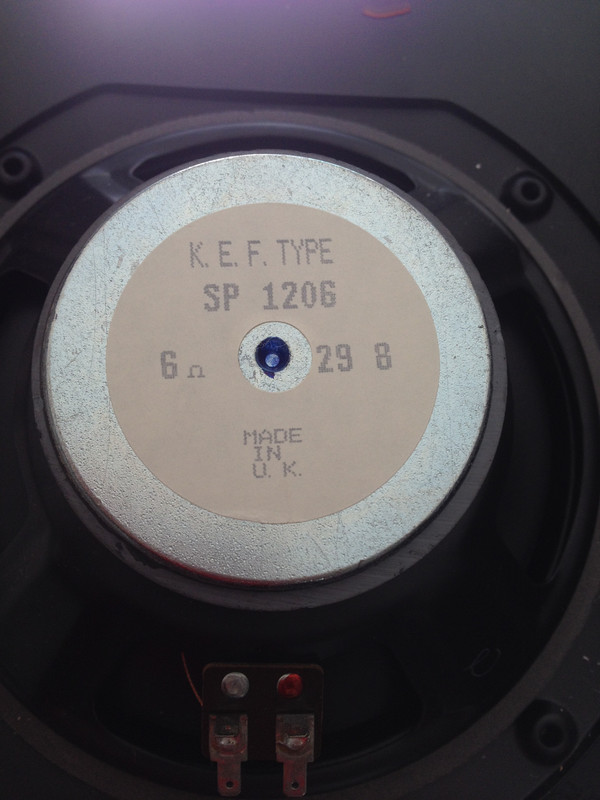
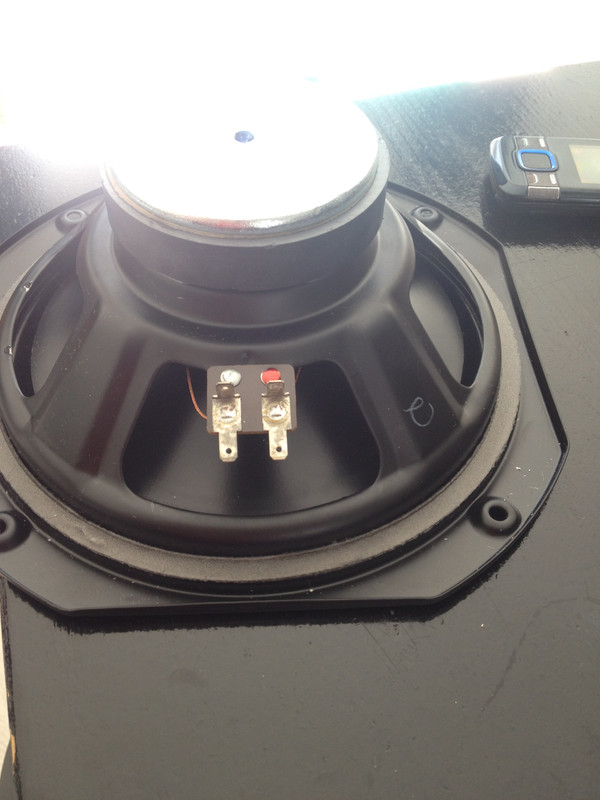
Tweeter was attached with purple and blue cable. Blue cable was attached to tweeter-connector with red dot.
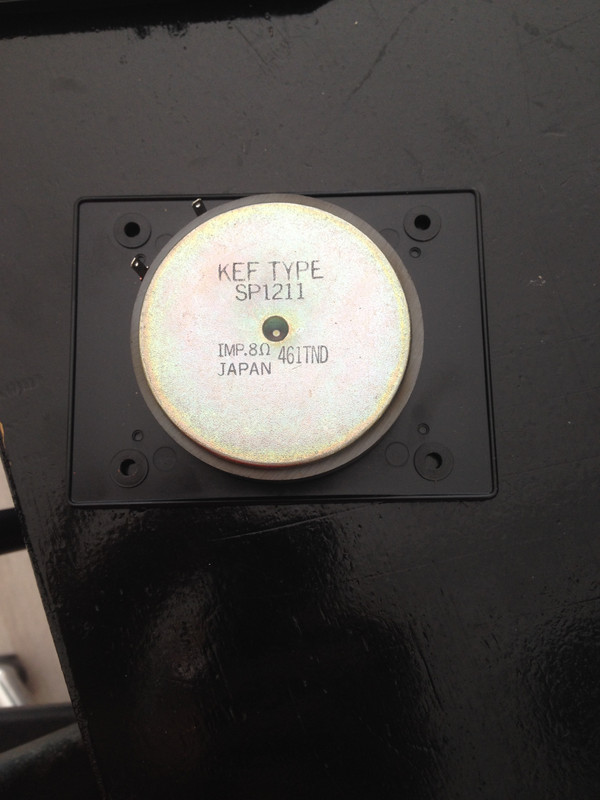
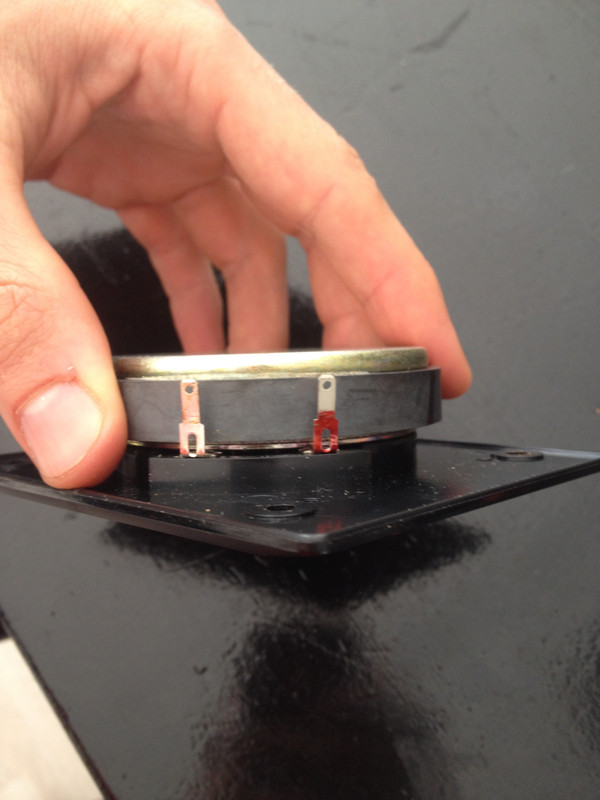
I disconnected the woofer and the tweeter to do the measurements. I did not remove the cross-over from the back of the speakerbox. As far as I can see without removing the cross-over I do not see any sign of over-heating damage or any broken solder or loose cables.
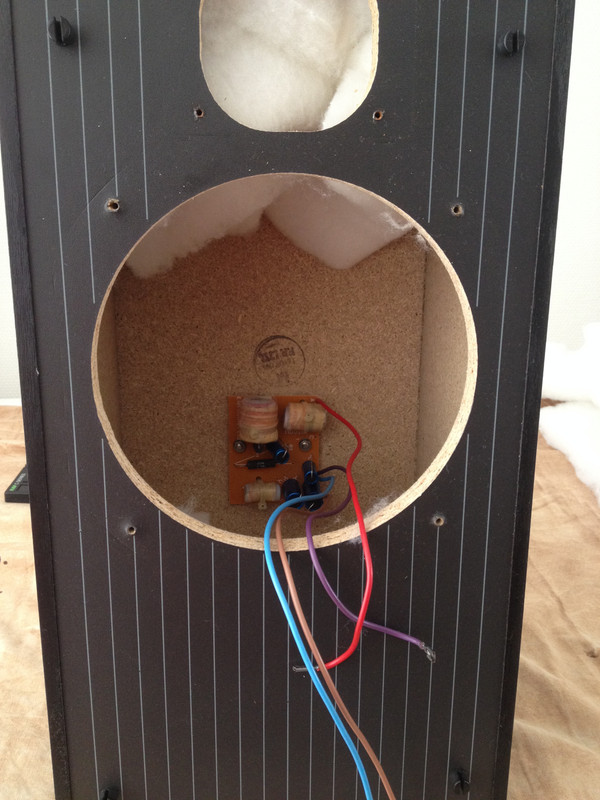
Resistance measurements:
Red binding post on outside red to red woofer cable: 1,0 ohm
Red binding post on outside red to purple woofer cable: infinite
Black binding post on outside red to red woofer cable: infinite
Black binding post on outside red to purple woofer cable: 0.6 ohm
Red binding post on outside red to blue tweeter cable: infinite
Red binding post on outside red to brown tweeter cable: infinite
Black binding post on outside red to blue tweeter cable: 0.6 ohm
Black binding post on outside red to brown tweeter cable: infinite
Between both connectors on woofer: infinite
Between both connectors on tweeter: 6,7 ohm
The conclusion I draw from these observations is that the woofer is probably broken (because of it's infinite resistance).
Can any of you shine any more light on my findings? Or maybe you have instructions for what more I should measure/investigate.
I did not dare to test the woofer or the tweeter in the other, still working, speaker, because I'm afraid that I could damage the undamaged electronics of the working speaker by introducing a faulty woofer/tweeter to it. Is this a true risk?
I'm looking in to this because I love to learn new things and also I hope to be able to repair/replace the broken part even if it costs some time/money.
Thanks in advance.
Specs of the Kef C30 speaker:
KEF C30 - Manual - Two Way Stand Mounting Loudspeaker System - HiFi Engine
I decided to open the faulty speaker to see if I could find any damage of the transport by bike and I took some resistance measurements of different parts of the electronics.
However my knowledge of electronics is limited to what I learned in secondary school physics and how a cross-over exactly works is a complete mystery to me. So I need some help with investigating what the defect in this speaker is.
Description of situation when I opened the speaker:
Woofer (see info in attached pictures) was attached with a red and a purple cable. Red cable was attached to the connector on the driver marked with red dot.


Tweeter was attached with purple and blue cable. Blue cable was attached to tweeter-connector with red dot.


I disconnected the woofer and the tweeter to do the measurements. I did not remove the cross-over from the back of the speakerbox. As far as I can see without removing the cross-over I do not see any sign of over-heating damage or any broken solder or loose cables.

Resistance measurements:
Red binding post on outside red to red woofer cable: 1,0 ohm
Red binding post on outside red to purple woofer cable: infinite
Black binding post on outside red to red woofer cable: infinite
Black binding post on outside red to purple woofer cable: 0.6 ohm
Red binding post on outside red to blue tweeter cable: infinite
Red binding post on outside red to brown tweeter cable: infinite
Black binding post on outside red to blue tweeter cable: 0.6 ohm
Black binding post on outside red to brown tweeter cable: infinite
Between both connectors on woofer: infinite
Between both connectors on tweeter: 6,7 ohm
The conclusion I draw from these observations is that the woofer is probably broken (because of it's infinite resistance).
Can any of you shine any more light on my findings? Or maybe you have instructions for what more I should measure/investigate.
I did not dare to test the woofer or the tweeter in the other, still working, speaker, because I'm afraid that I could damage the undamaged electronics of the working speaker by introducing a faulty woofer/tweeter to it. Is this a true risk?
I'm looking in to this because I love to learn new things and also I hope to be able to repair/replace the broken part even if it costs some time/money.
Thanks in advance.
It looks like you have Open Circuit woofer which can fail OC in several places such as Flex Leads, Voice Coil and VC to FL solder connections (under dust dome).
You can try probing for VC continuity by testing across where the FLs penetrate the cone.
Try manually operating the cone over it's travel and check for any mechanical scraping/scratching, if so you need a new woofer.
Max.
You can try probing for VC continuity by testing across where the FLs penetrate the cone.
Try manually operating the cone over it's travel and check for any mechanical scraping/scratching, if so you need a new woofer.
Max.
If what you have posted is correct, you also have a problem with the tweeter part: red binding post to brown cable should measure close to black binding post to blue cable.Red binding post on outside red to blue tweeter cable: infinite
Red binding post on outside red to brown tweeter cable: infinite
Black binding post on outside red to blue tweeter cable: 0.6 ohm
Black binding post on outside red to brown tweeter cable: infinite
As said in previous post, you have an open circuit woofer. I don't have direct experience in fixing that, but an OC is definitely better than a melted voice coil. Look at the woofer terminal and see if the wires are connected. The worst you have to do is to recone the woofer (the only way probably to reach the voice coil, assuming the wire is broken near it).Between both connectors on woofer: infinite
No risk, I'd would definitely do it, just to be sure that there aren't any other issues. In fact this is the best procedure for searching where the problem effectively lies.I did not dare to test the woofer or the tweeter in the other, still working, speaker, because I'm afraid that I could damage the undamaged electronics of the working speaker by introducing a faulty woofer/tweeter to it. Is this a true risk?
Ralf
I don't suppose you would relish paying £50 for a replacement? 😱
KEF TYPE SP 1206 Stereo SPEAKER 8" Low Frequency Driver Woofer TESTED 6ohm C30 | eBay
KEF TYPE SP 1206 Stereo SPEAKER 8" Low Frequency Driver Woofer TESTED 6ohm C30 | eBay
As Max has said can you verify the wire from the bass unit connectors to the voice coil is intact. You can easily see one wire in your images, the other one less so.
If you have a broken tinsel wire and the cone is a plastic type you will have to be very quick and carful about re soldering a new connection, ideally with some other very flexible type braid.
If you can fix the bass problem. The old bipolar capacitors are probably worth replacing in both pairs of speaker. Just go for a like for like replacement with bipolars, or plastic types if you can get them. Use a electrical parts supplier no need for exotic caps when you are starting out to fix things. Inexpensive bipolars were good enough for Kef and the majority of other manufacturers in those days
If you have a broken tinsel wire and the cone is a plastic type you will have to be very quick and carful about re soldering a new connection, ideally with some other very flexible type braid.
If you can fix the bass problem. The old bipolar capacitors are probably worth replacing in both pairs of speaker. Just go for a like for like replacement with bipolars, or plastic types if you can get them. Use a electrical parts supplier no need for exotic caps when you are starting out to fix things. Inexpensive bipolars were good enough for Kef and the majority of other manufacturers in those days
All a bit heatbreaking when old speakers have expensive faults, 😡
A broken tinsel lead might fix with a bit of reflow on the solder connection, but I wouldn't get my hopes up. As it goes, tinsel is quite a specialist wire:
Blue Aran - The UK's no.1 Loudspeaker Component Stockist > Speaker Components > Recone Parts > Tinsel Wire
Other stuff lasts about 5 minutes.
The crossover looks alright to me. 0.6 ohms is probably a resistance meter calibration error. Before measuring resistance, it is as well to touch the probes together and see what you get. Then subtract it. It's as easy to connect a 1.5V penlight battery across a speaker to see if it works and crackles.
Red is woofer positive.
Purple is woofer negative.
Brown is tweeter positive.
Blue is tweeter negative.
KEF usually wired tweeters negative polarity in this style. Bit like this:
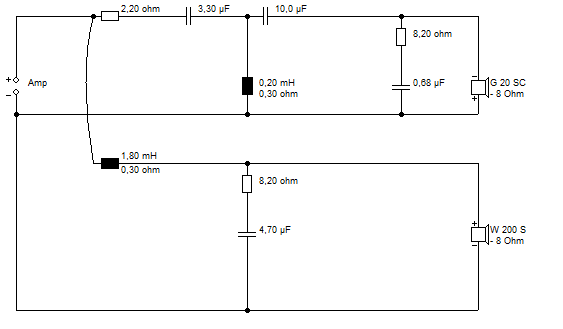
eBay looks a possibility, as does this:
WA - 206 Bass-mid Diameter 206mm
I am guessing that woofer is 210mm width, so the Wilmslow will fit. Goodish speakers worth fixing, IMO.
A broken tinsel lead might fix with a bit of reflow on the solder connection, but I wouldn't get my hopes up. As it goes, tinsel is quite a specialist wire:
Blue Aran - The UK's no.1 Loudspeaker Component Stockist > Speaker Components > Recone Parts > Tinsel Wire
Other stuff lasts about 5 minutes.
The crossover looks alright to me. 0.6 ohms is probably a resistance meter calibration error. Before measuring resistance, it is as well to touch the probes together and see what you get. Then subtract it. It's as easy to connect a 1.5V penlight battery across a speaker to see if it works and crackles.
Red is woofer positive.
Purple is woofer negative.
Brown is tweeter positive.
Blue is tweeter negative.
KEF usually wired tweeters negative polarity in this style. Bit like this:
eBay looks a possibility, as does this:
WA - 206 Bass-mid Diameter 206mm
I am guessing that woofer is 210mm width, so the Wilmslow will fit. Goodish speakers worth fixing, IMO.
Firstly, thank you all for your generous responses. It feels really heart-warming to be welcomed to the DIYaudio forum in this way.
When manually moving the woofer cone I hear a soft scraping sound, which the other (functioning) woofer does not have. I conclude from Max Planck's post that this means it is broken. What causes this scraping sound? And what kind of abuse could have caused this damage (e.g. playing music with too high volume by former owner or vibration during transportation on my bike?)
The woofer flex leads are continuous from the cable attachment to the point where they penetrate the cone. There is no continuity between the flex lead where it enters the cone to the other flex lead entering the cone.
I put the woofer of the functioning speaker in the other speaker and it produces sound normally, so that proves the crossover to be intact.
The two replacement woofers you recommended are a bit too expensive for me. I was hoping not to spend more than 30 euro's on a new woofer. What specifications do I have to take into account when selecting a replacement woofer? (resistance, RMS/max. power, min./max. frequency, sensitivity?)
When manually moving the woofer cone I hear a soft scraping sound, which the other (functioning) woofer does not have. I conclude from Max Planck's post that this means it is broken. What causes this scraping sound? And what kind of abuse could have caused this damage (e.g. playing music with too high volume by former owner or vibration during transportation on my bike?)
The woofer flex leads are continuous from the cable attachment to the point where they penetrate the cone. There is no continuity between the flex lead where it enters the cone to the other flex lead entering the cone.
I put the woofer of the functioning speaker in the other speaker and it produces sound normally, so that proves the crossover to be intact.
The two replacement woofers you recommended are a bit too expensive for me. I was hoping not to spend more than 30 euro's on a new woofer. What specifications do I have to take into account when selecting a replacement woofer? (resistance, RMS/max. power, min./max. frequency, sensitivity?)
It seems likely that the voice coil of the woofer has been overheated by playing too loud.
The sound you hear is the damaged voice coil scraping in the magnet gap.
A replacement woofer would require to have similar Thiele/Small parameters to the original one.
Steve (system7) has suggested a replacement from Wilmslow Audio which is compatible with the original KEF woofer.
The sound you hear is the damaged voice coil scraping in the magnet gap.
A replacement woofer would require to have similar Thiele/Small parameters to the original one.
Steve (system7) has suggested a replacement from Wilmslow Audio which is compatible with the original KEF woofer.
Last edited:
First measure the diameter of the woofer cutout in the cabinet to make sure that any replacement will physically fit that aperture.
For example, the Wilmslow Audio WA-206 requires a cutout diameter of 185mm. WA - 206 Bass-mid Diameter 206mm
For example, the Wilmslow Audio WA-206 requires a cutout diameter of 185mm. WA - 206 Bass-mid Diameter 206mm
- Home
- Loudspeakers
- Multi-Way
- Help me troubleshoot a broken Kef C30 speaker